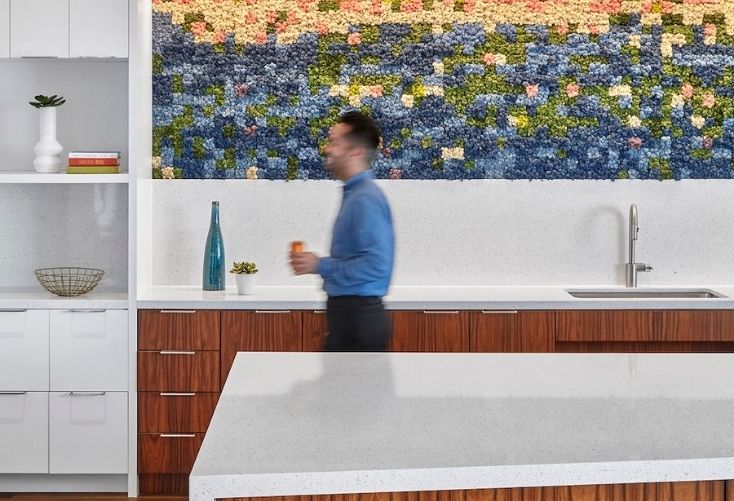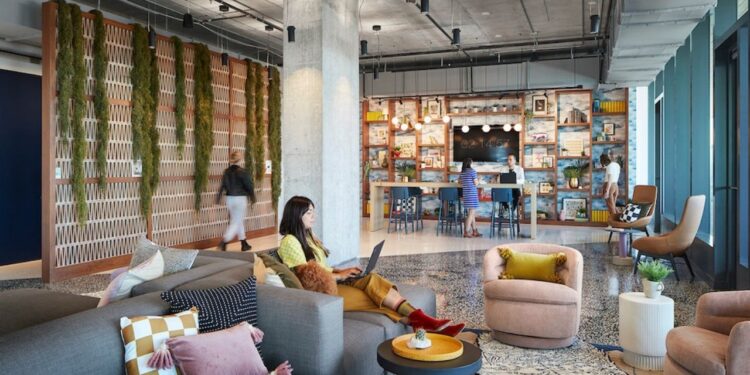- A recent survey showed that 52% of office workers want to maintain a hybrid work model in a post pandemic future.
- Bill Browning, environmental strategist and founding partner of sustainability consulting firm Terrapin Bright Green, said in an interview with Coalesse that biophilia can lower stress, improve cognitive function, and enhance a person’s mood and creativity.
- A research study conducted in Sweden during the pandemic, showed that people turned to urban nature due to a variety of positive well-being effects.
This article was written by Khoi Hoang and was originally published on Work Design Magazine.
Prior to the pandemic, access to daylight, greenspaces, and the natural environment was paramount to the evolution of the workspace. Now as more people are returning to the office, biophilic designs – the notion that humans are intrinsically drawn and attracted to nature – are becoming more and more central to office environments.
As more organizations are welcoming employees back to the workplace, there are certain amenities and experiences workers are looking for to make them feel healthier and safer. It has become essential for a workspace to offer access to greenspace, natural light, and fresh air, to contribute to the overall health and productivity of employees.
A recent survey showed that 52% of office workers want to maintain a hybrid work model in a post pandemic future.
Going back to the office on a hybrid work model means that employees must have strategies in place for how they want to be able to spend their workweek and how that parcels out in alignment with their new lifestyle.
So, how do Biophilic principles play into these strategies? And how can employers help support this transition?
…Biophilia can lower stress, improve cognitive function, and enhance a person’s mood and creativity.
During the pandemic, numerous reports and data mapping were conducted to show the impact of greenspace and how it was utilized during multiple lockdowns and bouts of isolation.
Bill Browning, environmental strategist and founding partner of sustainability consulting firm Terrapin Bright Green, said in an interview with Coalesse that biophilia can lower stress, improve cognitive function, and enhance a person’s mood and creativity.
In a study reported by William L. Rice and Bing Pan on understanding the correlation between outdoor park visitations and wellness during the pandemic, findings showed that visit restrictions and rates of infection were linked to a community’s capacity to cope with the health crisis.
Further mapping revealed the increase of parks and outdoor space visitation during the last two years was more than a trend, it was a reinforcement that greenspace as a place of respite, healing and reflection during times of crisis, is vitally important.
Drawing from this data, we are working to re-imagine the workplace in a post pandemic world, with biophilic strategies to further enhance these solutions.

Connection everywhere
During the pandemic, each person became their own office. The office as a formal location changed overnight as employees sought refuge in their own homes, and as beds became workstations, and dining tables became conference rooms.
The attitude that the office is everywhere you want it is key to the new workspace landscape. A strong internet connection is paramount in easing back to the office. Enticing terraces and outdoor courtyards are infinitely more attractive with a strong internet connection or mobile hotspots. Spending time working on an important deliverable is more enjoyable (and healthier) if you can do it on a patio.
A research study conducted in Sweden during the pandemic, showed that people turned to urban nature due to a variety of positive well-being effects. Data highlighted that access to the outside is important for urban resilience in the short-and long-term. In the short-term, it provides much-needed buffering capacity for maintaining mental and physical health, social relationships, and communion with the natural world.
At the same time, how space and property rights are arranged to ensure access to urban nature is important for building general urban resilience in the long-term.

Disconnect and Unwind
Not all workspaces have access to a terrace or a park within walking distance. How can an existing office lacking these features adapt? The flexible nature of wellness rooms as a place of respite and relaxation can be further enhanced through utilizing plants, lighting, and soundscapes.
Existing wellness rooms are usually located near the core, away from natural light; utilizing full spectrum panels to simulate daylight or a simple switch to an adjustable bulb can go a long way. Supplying humidifiers, potted plants and nature inspired wallcovering in conjunction with guided meditation apps such as Calm are becoming the commonplace as an amenity offering. Another alternative would be utilizing a tech-free approach by helping discourage smart phone usage in the wellness rooms; enabling workers to fully disengage and practice mindfulness even if it is for a brief while.
Other workplace typologies that can benefit from these strategies are conference rooms. Meeting types are becoming more varied, and the rise of the single/two persons focus or “zoom rooms” are becoming the norm. Incorporating potted plants, good access to natural light or inferred natural light are effective strategies in making the office experience more enjoyable and productive.

Green Equals Life
The incorporation of plants throughout the workspace has shown to decrease stress and increase productivity. Spending time with others in nature has shown to increase social cohesion. With access to personal greenspace such as a backyard or garden becoming increasingly rare nowadays as the younger workforce reside in high density housing.
Programs such as a community gardens, potting and gardening courses, even a simple herb garden at work, provides opportunities for employees to customize their workspace and contribute to an overall healthier lifestyle.
Biophilic principles are not new in interior design or in wellness practices. But leaning into the data that has been compiled to further reinforce the ability of nature to help us maintain balance, connect, and unwind will be more important than ever to help transition people back to the office.
Supporters of this approach insist that design that incorporates nature or mimics natural systems are linked to decreased stress, increased creativity, and accelerated recovery from illness. In the workplace, it can also lead to financial benefits such as a reduction in use of sick days.
Lastly, creating more opportunities for enhanced lighting, and air and space as an architectural strategy, these timeless attributes are now more essential for workers to feel comfortable and safe. Office environments with abundant natural light, enhanced air filtration, and generous common areas for circulation, waiting, and staging will be the most desirable, and needed in the future.


 Dr. Gleb Tsipursky – The Office Whisperer
Dr. Gleb Tsipursky – The Office Whisperer Nirit Cohen – WorkFutures
Nirit Cohen – WorkFutures Angela Howard – Culture Expert
Angela Howard – Culture Expert Drew Jones – Design & Innovation
Drew Jones – Design & Innovation Jonathan Price – CRE & Flex Expert
Jonathan Price – CRE & Flex Expert













